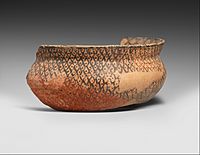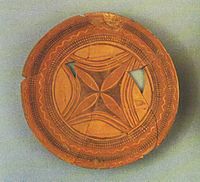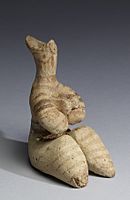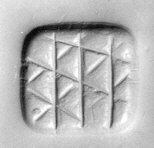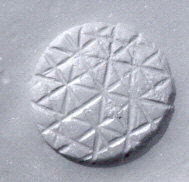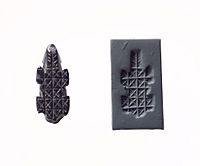Halaf culture facts for kids
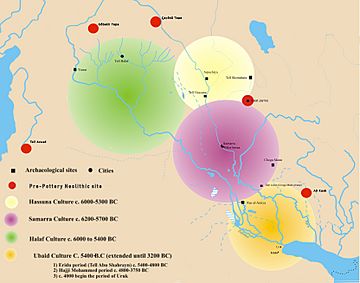 Halaf culture (in green), next to Samarra, Hassuna and Ubaid cultures. |
|
| Geographical range | Mesopotamia |
|---|---|
| Period | Neolithic 3 – Pottery Neolithic (PN) |
| Dates | c. 6,100–5,100 BC |
| Type site | Tell Halaf |
| Major sites | Tell Brak |
| Preceded by | Pre-Pottery Neolithic B, Yarmukian culture |
| Followed by | Halaf-Ubaid Transitional period, Hassuna culture, Samarra culture |
The Halaf culture was an ancient way of life that existed a very long time ago, from about 6100 BC to 5100 BC. It was a natural step forward from an earlier time called the Pottery Neolithic period. This culture was mostly found in the rich Khabur River valley. This area is in what is now southeastern Turkey, Syria, and northern Iraq. However, signs of the Halaf culture have been found all over a larger area called Mesopotamia.
The culture gets its name from a place called Tell Halaf in northern Syria. An archaeologist named Max von Oppenheim dug there between 1911 and 1927. But the very first Halaf items were found earlier, in 1908, by John Garstang at Sakce Gözü. More Halaf items were also found in 1913 by Leonard Woolley at Carchemish. This site is on the border between Turkey and Syria. Yet, the most important place for learning about the Halaf culture was Tell Arpachiyah. This site is now part of Mosul, a city in Iraq.
The Halaf period eventually changed into the Halaf-Ubaid Transitional period. This was followed by the Ubaid period.
Contents
Where Did the Halaf Culture Begin?
For a long time, experts thought the Halaf culture did not start in the Syrian plains. They believed the Halaf people came from the nearby mountains of southeastern Anatolia. Others thought they were herders from northern Iraq.
But new discoveries have changed these ideas. Since 1986, archaeologist Peter Akkermans has led digs that found new information. They uncovered a previously unknown culture in the Balikh valley. This was at a place called Tell Sabi Abyad, which means "Mound of the White Boy."
At Sabi Abyad, eleven layers of human settlement have been found. The lowest layers (11 to 7) are from before the Halaf culture. Layers 6 to 4 show a transition between the old ways and the Halaf culture. The top layers (3 to 1) are from the early Halaf period. This shows that people lived there continuously. There was no break in settlement, except for a small gap between layers 11 and 10.
These new findings prove that the Halaf culture did not appear suddenly. It was not brought by people from other places. Instead, it grew slowly from changes in the local culture in northern Syria. From there, it spread to other regions.
Halaf Culture: What Was It Like?
Halaf Pottery: Beautiful Designs
Halaf pottery is very special. It has been found in many parts of northern Mesopotamia. These places include Nineveh, Tepe Gawra, Chagar Bazar, and Tell Amarna. It was also found at many sites in Anatolia (Turkey). This suggests that this pottery was widely used across the region.
-
Fragment of a bowl; 5600–5000 BC; ceramic; 8.2 cm; Metropolitan Museum of Art (New York City)
-
Fertility figurine (maybe a goddess?); 5000–4000 BC; terracotta with traces of pigment; 8.1 × 5 × 5.4 cm; by Halaf culture; Walters Art Museum (Baltimore, US)
Stamp Seals: Early Signatures
The Halaf culture also saw the first known use of stamp seals in the Near East. These small objects were used to press a design into clay. They often had simple geometric patterns. People might have used them to mark their belongings or to sign documents.
How the Halaf Culture Ended
The Halaf culture came to an end around 5000 BC. This happened during a time called the Halaf-Ubaid Transitional period. Many Halaf settlements were left empty. The places that continued to be lived in started to show signs of the Ubaid culture.
This new period is sometimes called Northern Ubaid. This helps to tell it apart from the Ubaid culture in southern Mesopotamia. There are two main ideas about why this change happened. One idea was that the Ubaid people invaded and took over from the Halaf people. However, there is no break in the archaeological record between the Halaf and Northern Ubaid periods. This makes the invasion idea unlikely.
The most likely idea is that the Halaf people simply adopted the Ubaid culture. This means they started to use Ubaid styles and ways of life. Many experts, like Oates, Breniquet, and Akkermans, support this idea.
See also
 In Spanish: Cultura de Halaf para niños
In Spanish: Cultura de Halaf para niños


